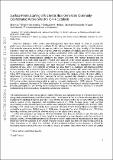Surface Restructuring of Nickel Sulfide Generates Optimally Coordinated Active Sites for Oxygen Reduction Catalysis
Author(s)
Yan, Bing; Krishnamurthy, Dilip; Hendon, Christopher H; Deshpande, Siddharth; Surendranath, Yogesh; Viswanathan, Venkatasubramanian; ... Show more Show less
DownloadSubmitted version (4.241Mb)
Terms of use
Metadata
Show full item recordAbstract
The Ni₃S₂ bulk phase supports efficient oxygen reduction reaction (ORR) catalysis in pH neutral aqueous electrolytes. Here, we combine electrochemistry, surface spectroscopy, and high-resolution microscopy to show that Ni₃S₂ undergoes self-limiting oxidative surface restructuring under ORR conditions to form an amorphous surface film conformally coating the Ni₃S₂ crystallites. The surface film has a nominal NiS stoichiometry and is highly active for ORR catalysis. Density functional theory calculations suggest that, to a first approximation, the catalytic activity of nickel sulfides is determined by the Ni-S coordination numbers at surface-exposed sites through a simple geometric descriptor. In particular, Ni surface sites with three S nearest neighbors, formed via reconstruction of the Ni3S2 surface, provide an optimal energetic landscape for ORR catalysis. By providing a framework for understanding catalytic activity on reconstructed amorphous surface phases, the work enables the rational design of high-performance electrocatalysts based on kinetically labile, earth-abundant materials. In heterogeneous catalysis, only the surface of the active material is responsible for catalytic turnover. These surfaces often undergo dynamic changes that lead to altered structures and compositions relative to the bulk of the material. Thus, the development of improved catalysts requires a detailed understanding of these surface dynamics under the conditions of the reaction. Here, we uncover these dynamics on an earth-abundant catalyst, Ni₃S₂, that is highly active for the conversion of oxygen to water, the efficiency-limiting reaction in low-temperature fuel cells. We demonstrate that the surface of this material transforms into a disordered and active ∼2 nm NiS layer. We establish that the activity of materials of this type can be estimated by simply considering the number of S atoms directly bonded to the Ni active sites on the surface. This simple geometric descriptor enables the rational design of the disordered structures that persist on many catalytically active surfaces. Crystalline Ni₃S₂ oxygen reduction reaction (ORR) catalysts undergo oxidative surface reconstruction under catalytic conditions to generate an approximately 2 nm amorphous surface layer with NiS stoichiometry. DFT calculations establish a simple local coordination number based descriptor for ORR catalysis and suggest that Ni atoms surrounded by three S nearest neighbors display optimal activity. The surface reconstructed Ni₃S₂ exhibits similar ORR activity to electrodeposited amorphous NiS films.
Date issued
2017-09Department
Massachusetts Institute of Technology. Department of ChemistryJournal
Joule
Publisher
Elsevier BV
Citation
Yan, Bing et al. "Surface Restructuring of Nickel Sulfide Generates Optimally Coordinated Active Sites for Oxygen Reduction Catalysis." Joule 1, 3 (November 2017): P600-612 © 2017 Elsevier Inc
Version: Original manuscript
ISSN
2542-4351